View in other NatureServe Network Field Guides
NatureServe
Montana
Utah
Wyoming
Idaho
Wisconsin
British Columbia
South Carolina
Yukon
California
New York
Thirteen-lined Ground Squirrel - Ictidomys tridecemlineatus
Native Species
Global Rank:
G5
State Rank:
S5
(see State Rank Reason below)
Agency Status
USFWS:
USFS:
BLM:
External Links
State Rank Reason (see State Rank above)
Species is rarely observed but common to uncommon across much of central and eastern Montana. It readily uses disturbed habitats and coexists well with agriculture. No threats are known.
General Description
We do not yet have descriptive information on this species. Please try the buttons above to search for information from other sources.
Species Range
Montana Range
Range Descriptions
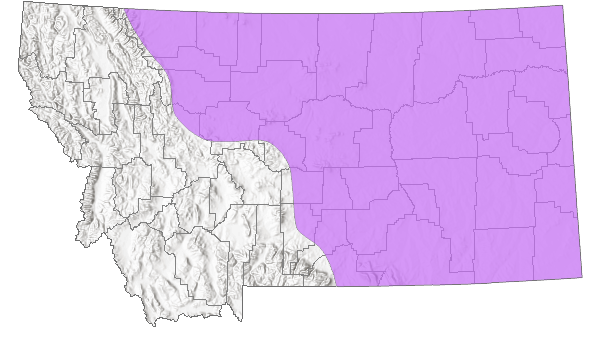
 Native
Native
Western Hemisphere Range

Observations in Montana Natural Heritage Program Database
Number of Observations: 269
(Click on the following maps and charts to see full sized version)
Map Help and Descriptions
Relative Density
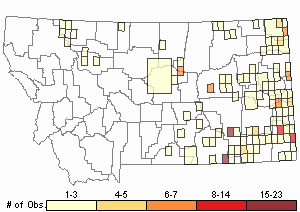
Recency
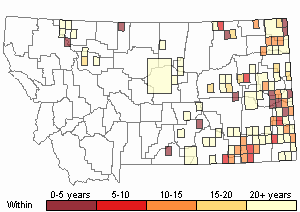
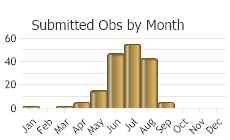
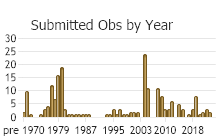
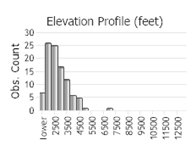 (Observations spanning multiple months or years are excluded from time charts)
(Observations spanning multiple months or years are excluded from time charts)
Migration
Non-migratory.
Habitat
Tallgrass, brushy edges, herbaceous vegetation, dense cover. However, also occurs in shortgrass and sagebrush, upland meadows. May prefer grazed and mowed grasslands.
National Vegetation Classification System Groups Associated with this Species
Forest and Woodland
Deciduous Forest and Woodland
Low Elevation - Xeric Forest and Woodland
Shrubland
Sagebrush Shrubland
Grassland
Lowland - Prairie Grassland
Sparse and Barren
Sparse and Barren
Wetland and Riparian
Riparian and Wetland Forest
Riparian Shrubland
Recently Disturbed or Modified
Introduced Vegetation
Human Land Use
Agriculture
Developed
Food Habits
Insects are an important dietary component in spring, summer, and early fall; sometimes influencing habitat selection. Seeds, grasses, flowers, and fruits form the remainder. Will prey on small vertebrates.
Ecology
Beneficial in that it consumes many insects. Sometimes detrimental by destroying newly planted grain.
Reproductive Characteristics
Breeds in April to early May (approximately 5 days after females emerge). Induced ovulation. Probably monestrous in Montana.
Stewardship Responsibility
References
- Additional ReferencesLegend:
 View Online Publication
View Online Publication
Do you know of a citation we're missing? [PRESI] Powder River Eagle Studies Incorporated. 1998b. Spring Creek Mine 1997 wildlife monitoring studies. Powder River Eagle Studies Incorporated. Gillete, WY.
[PRESI] Powder River Eagle Studies Incorporated. 1998b. Spring Creek Mine 1997 wildlife monitoring studies. Powder River Eagle Studies Incorporated. Gillete, WY. Becker, D.M. 1984. Reproductive ecology and habitat utilization of Richardson's Merlins in southeastern Montana. M.Sc. Thesis. Missoula, MT: University of Montana. 62 p.
Becker, D.M. 1984. Reproductive ecology and habitat utilization of Richardson's Merlins in southeastern Montana. M.Sc. Thesis. Missoula, MT: University of Montana. 62 p. Clark, T.W. 1971. Notes of the biology of the thirteen-lined ground squirrel on the Laramie Plains, Wyo. The Southwestern Naturalist. 15(4): 499-502.
Clark, T.W. 1971. Notes of the biology of the thirteen-lined ground squirrel on the Laramie Plains, Wyo. The Southwestern Naturalist. 15(4): 499-502. Clark, T.W. 1981. Some spatial and behavioral features of the thirteen-lined ground squirrel. Great Basin Naturalist. 41(2): 243-246.
Clark, T.W. 1981. Some spatial and behavioral features of the thirteen-lined ground squirrel. Great Basin Naturalist. 41(2): 243-246. Dames & Moore. 1975. Interim report environmental baseline studies for Crow Indian coal leases: known as Tract II and Tract III, Westmoreland Resources, Sarpy Creek Basin, Big Horn County, Montana. Billings, Mont.
Dames & Moore. 1975. Interim report environmental baseline studies for Crow Indian coal leases: known as Tract II and Tract III, Westmoreland Resources, Sarpy Creek Basin, Big Horn County, Montana. Billings, Mont. Dood, A.R. 1980. Terry Badlands nongame survey and inventory final report. Montana Department of Fish, Wildlife, and Parks and Bureau of Land Management, Helena, MT. 70 pp.
Dood, A.R. 1980. Terry Badlands nongame survey and inventory final report. Montana Department of Fish, Wildlife, and Parks and Bureau of Land Management, Helena, MT. 70 pp. Ecological Consulting Service, Helena, MT., 1975, Peabody Coal Company Big Sky Mine: Wildlife environmental indicators monitoring survey. Progress report. Project 58-23-A. June 16, 1975.
Ecological Consulting Service, Helena, MT., 1975, Peabody Coal Company Big Sky Mine: Wildlife environmental indicators monitoring survey. Progress report. Project 58-23-A. June 16, 1975. ECON, Inc. (Ecological Consulting Service), Helena, MT., 1976, Colstrip 10 x 20 Area wildlife and wildlife habitat annual monitoring report, 1976. Proj. 135-85-A. December 31, 1976.
ECON, Inc. (Ecological Consulting Service), Helena, MT., 1976, Colstrip 10 x 20 Area wildlife and wildlife habitat annual monitoring report, 1976. Proj. 135-85-A. December 31, 1976. ECON, Inc. (Ecological Consulting Service), Helena, MT., 1979, Annual wildllife report of the Colstrip Area for 1978. Proj. 195-85-A. April 6, 1979.
ECON, Inc. (Ecological Consulting Service), Helena, MT., 1979, Annual wildllife report of the Colstrip Area for 1978. Proj. 195-85-A. April 6, 1979. ECON, Inc. (Ecological Consulting Service), Helena, MT., 1979, Annual wildllife report of the Colstrip Area for 1979, including a special raptor research study. Proj. 216-85-A. March 1, 1980.
ECON, Inc. (Ecological Consulting Service), Helena, MT., 1979, Annual wildllife report of the Colstrip Area for 1979, including a special raptor research study. Proj. 216-85-A. March 1, 1980. ECON, Inc. (Ecological Consulting Service), Helena, MT., 1979, Area B four-section wildlife report. August 3, 1979.
ECON, Inc. (Ecological Consulting Service), Helena, MT., 1979, Area B four-section wildlife report. August 3, 1979. Econ, Inc. 1988. Wildlife monitoring report, 1987 field season, Big Sky Mine. March 1988. In Peabody Mining and Reclamation Plan Big Sky Mine Area B. Vol. 8, cont., Tab 10 - Wildlife Resources. Appendix 10-1, 1987 Annual Wildlife Report.
Econ, Inc. 1988. Wildlife monitoring report, 1987 field season, Big Sky Mine. March 1988. In Peabody Mining and Reclamation Plan Big Sky Mine Area B. Vol. 8, cont., Tab 10 - Wildlife Resources. Appendix 10-1, 1987 Annual Wildlife Report. Econ, Inc., Helena, MT., 1978, Peabody Coal Company Big Sky Mine, Rosebud County, MT. Wildlife and wildlife habitat monitoring study. Proj. 190-85-A. December 31, 1978.
Econ, Inc., Helena, MT., 1978, Peabody Coal Company Big Sky Mine, Rosebud County, MT. Wildlife and wildlife habitat monitoring study. Proj. 190-85-A. December 31, 1978. Fjell, Alan K., 1986, Peabody Coal Company Big Sky Mine, Rosebud County, MT. Wildlife monitoring report: 1985 field season. March 1986.
Fjell, Alan K., 1986, Peabody Coal Company Big Sky Mine, Rosebud County, MT. Wildlife monitoring report: 1985 field season. March 1986. Fjell, Alan K., and Brian R. Mahan, compilers., 1984, Peabody Coal Company Big Sky Mine, Rosebud County, MT. Wildlife monitoring report: 1983 field season. February 1984.
Fjell, Alan K., and Brian R. Mahan, compilers., 1984, Peabody Coal Company Big Sky Mine, Rosebud County, MT. Wildlife monitoring report: 1983 field season. February 1984. Fjell, Alan K., and Brian R. Mahan., 1983, Peabody Coal Company Big Sky Mine, Rosebud County, MT. Wildlife monitoring report: 1982 field season. May 1983.
Fjell, Alan K., and Brian R. Mahan., 1983, Peabody Coal Company Big Sky Mine, Rosebud County, MT. Wildlife monitoring report: 1982 field season. May 1983. Fjell, Alan K., and Brian R. Mahan., 1985, Peabody Coal Company Big Sky Mine, Rosebud County, MT. Wildlife monitoring report: 1984 field season. February 1985.
Fjell, Alan K., and Brian R. Mahan., 1985, Peabody Coal Company Big Sky Mine, Rosebud County, MT. Wildlife monitoring report: 1984 field season. February 1985. Fjell, Alan K., and Brian R. Mahan., 1987, Big Sky Mine, Rosebud County, MT. Wildlife monitoring report: 1986 field season. April 1987.
Fjell, Alan K., and Brian R. Mahan., 1987, Big Sky Mine, Rosebud County, MT. Wildlife monitoring report: 1986 field season. April 1987. Foresman, K.R. 2001. The wild mammals of Montana. American Society of Mammalogists, Special Publication Number 12. Lawrence, KS. 278 pp.
Foresman, K.R. 2001. The wild mammals of Montana. American Society of Mammalogists, Special Publication Number 12. Lawrence, KS. 278 pp. Foresman, K.R. 2012. Mammals of Montana. Second edition. Mountain Press Publishing, Missoula, Montana. 429 pp.
Foresman, K.R. 2012. Mammals of Montana. Second edition. Mountain Press Publishing, Missoula, Montana. 429 pp. Gniadek, S. 1983. Southwest Glendive Wildlife Baseline Inventory. Miles City, Mont: Bureau of Land Management, Miles City District Office. 56 pp with appendices.
Gniadek, S. 1983. Southwest Glendive Wildlife Baseline Inventory. Miles City, Mont: Bureau of Land Management, Miles City District Office. 56 pp with appendices. Goldan, D.S. 1982. Baseline data on vegetation, breeding bird populations, and small mammals in relation to proposed contour furrowing in southeastern Montana. M.Sc. Thesis. Bozeman, MT: Montana State University. 29 p.
Goldan, D.S. 1982. Baseline data on vegetation, breeding bird populations, and small mammals in relation to proposed contour furrowing in southeastern Montana. M.Sc. Thesis. Bozeman, MT: Montana State University. 29 p. Hanauska-Brown, L., B.A. Maxell, A. Petersen, and S. Story. 2014. Diversity Monitoring in Montana 2008-2010 Final Report. Montana Fish, Wildlife & Parks. Helena, MT. 78 pp.
Hanauska-Brown, L., B.A. Maxell, A. Petersen, and S. Story. 2014. Diversity Monitoring in Montana 2008-2010 Final Report. Montana Fish, Wildlife & Parks. Helena, MT. 78 pp. Hendricks, P., S. Lenard, D.M. Stagliano, and B.A. Maxell. 2013. Baseline nongame wildlife surveys on the Fort Peck Indian Reservation. Report to the Assiniboine and Sioux Tribes of the Fort Peck Indian Reservation. Montana Natural Heritage Program, Helena, MT. 83 p.
Hendricks, P., S. Lenard, D.M. Stagliano, and B.A. Maxell. 2013. Baseline nongame wildlife surveys on the Fort Peck Indian Reservation. Report to the Assiniboine and Sioux Tribes of the Fort Peck Indian Reservation. Montana Natural Heritage Program, Helena, MT. 83 p. Hoffmann, R.S. and D.L. Pattie. 1968. A guide to Montana mammals: identification, habitat, distribution, and abundance. Missoula, MT: University of Montana. 133 p.
Hoffmann, R.S. and D.L. Pattie. 1968. A guide to Montana mammals: identification, habitat, distribution, and abundance. Missoula, MT: University of Montana. 133 p. Humphris, Michael., 1990, Wildlife Monitoring Report. Spring Creek Coal Company 1990 Mining Annual Report. Appendix I. April 11, 1990.
Humphris, Michael., 1990, Wildlife Monitoring Report. Spring Creek Coal Company 1990 Mining Annual Report. Appendix I. April 11, 1990. Humphris, Michael., 1993, Wildlife Monitoring Report. Spring Creek Coal Company 1993 Mining Annual Report. Appendix I. April 11, 1993.
Humphris, Michael., 1993, Wildlife Monitoring Report. Spring Creek Coal Company 1993 Mining Annual Report. Appendix I. April 11, 1993. Humphris, Michael., 1994, Wildlife Monitoring Report. Spring Creek Coal Company 1994 Mining Annual Report. Appendix I. April 1994.
Humphris, Michael., 1994, Wildlife Monitoring Report. Spring Creek Coal Company 1994 Mining Annual Report. Appendix I. April 1994. Joslin, Gayle, and Heidi B. Youmans. 1999. Effects of recreation on Rocky Mountain wildlife: a review for Montana. [Montana]: Montana Chapter of the Wildlife Society.
Joslin, Gayle, and Heidi B. Youmans. 1999. Effects of recreation on Rocky Mountain wildlife: a review for Montana. [Montana]: Montana Chapter of the Wildlife Society. Lampe, R.P., J.K. Jones Jr., R.S. Hoffmann, and E.C. Birney. 1974. The mammals of Carter County, southeastern Montana. Occa. Pap. Mus. Nat. Hist. Univ. Kan. 25:1-39.
Lampe, R.P., J.K. Jones Jr., R.S. Hoffmann, and E.C. Birney. 1974. The mammals of Carter County, southeastern Montana. Occa. Pap. Mus. Nat. Hist. Univ. Kan. 25:1-39. MacCracken, J.G., D.W. Uresk, and R.M. Hansen. 1985. Rodent-vegetation relationships in southeastern Montana. Northwest Science 59:272-278.
MacCracken, J.G., D.W. Uresk, and R.M. Hansen. 1985. Rodent-vegetation relationships in southeastern Montana. Northwest Science 59:272-278. Martin, P.R., K. Dubois and H.B. Youmans. 1981. Terrestrial wildlife inventory in selected coal areas, Powder River resources area final report. Montana Department of Fish, Wildlife and Parks and Bureau of Land Management, Helena, MT. No. YA-553-CTO- 24. 288 p.
Martin, P.R., K. Dubois and H.B. Youmans. 1981. Terrestrial wildlife inventory in selected coal areas, Powder River resources area final report. Montana Department of Fish, Wildlife and Parks and Bureau of Land Management, Helena, MT. No. YA-553-CTO- 24. 288 p. Matthews, W.L. 1980a. Wibaux-Beach comparison study: Sydney, Glendive and Plevna Study Areas. Bureau of Land Management, Miles City, MT. 50 p.
Matthews, W.L. 1980a. Wibaux-Beach comparison study: Sydney, Glendive and Plevna Study Areas. Bureau of Land Management, Miles City, MT. 50 p. Matthews, W.L. 1981. Broadus-Pumpkin Creek baseline inventory - wildlife. Bureau of Land Management, Miles City, MT. 83 p.
Matthews, W.L. 1981. Broadus-Pumpkin Creek baseline inventory - wildlife. Bureau of Land Management, Miles City, MT. 83 p. Maxell, B.A. 2016. Northern Goshawk surveys on the Beartooth, Ashland, and Sioux Districts of the Custer-Gallatin National Forest: 2012-2014. Montana Natural Heritage Program. Helena, MT. 114pp.
Maxell, B.A. 2016. Northern Goshawk surveys on the Beartooth, Ashland, and Sioux Districts of the Custer-Gallatin National Forest: 2012-2014. Montana Natural Heritage Program. Helena, MT. 114pp. Pefaur, J. E., and R. S. Hoffmann. 1975. Studies of small mammal populations at three sites on the Northern Great Plains. Occasional Papers of the Museum of Natural History, University of Kansas, Lawrence. No. 37:1-27.
Pefaur, J. E., and R. S. Hoffmann. 1975. Studies of small mammal populations at three sites on the Northern Great Plains. Occasional Papers of the Museum of Natural History, University of Kansas, Lawrence. No. 37:1-27. Perry, N. and R. Davis. 2000. Small Mammal Diversity and Abundance on Two Habitat Types at Medicine Lake and Lostwood National Wildlife Refuges. Unpublished report. 8 pp.
Perry, N. and R. Davis. 2000. Small Mammal Diversity and Abundance on Two Habitat Types at Medicine Lake and Lostwood National Wildlife Refuges. Unpublished report. 8 pp. Powder River Eagle Studies, Inc., Gillette, WY., 1996, Spring Creek Mine 1995 Wildlife Monitoring Studies. Spring Creek Coal Company 1995-1996 Mining Annual Report. Vol. I, App. I. May 1996.
Powder River Eagle Studies, Inc., Gillette, WY., 1996, Spring Creek Mine 1995 Wildlife Monitoring Studies. Spring Creek Coal Company 1995-1996 Mining Annual Report. Vol. I, App. I. May 1996. Powder River Eagle Studies, Inc., Gillette, WY., 1997, Spring Creek Mine 1996 Wildlife Monitoring Studies. February 1997.
Powder River Eagle Studies, Inc., Gillette, WY., 1997, Spring Creek Mine 1996 Wildlife Monitoring Studies. February 1997. Powder River Eagle Studies, Inc., Gillette, WY., 2000, Spring Creek Mine 2000 Wildlife Monitoring. March 2000.
Powder River Eagle Studies, Inc., Gillette, WY., 2000, Spring Creek Mine 2000 Wildlife Monitoring. March 2000. Powder River Eagle Studies, Inc., Gillette, WY., 2002, Spring Creek Mine 2001 Wildlife Monitoring. March 2002
Powder River Eagle Studies, Inc., Gillette, WY., 2002, Spring Creek Mine 2001 Wildlife Monitoring. March 2002 Reid, F. 2006. Peterson Field Guide to Mammals of North America, 4th Edition. Houghton Mifflin Company: Boston and New York, 608 pp.
Reid, F. 2006. Peterson Field Guide to Mammals of North America, 4th Edition. Houghton Mifflin Company: Boston and New York, 608 pp. Rongstad, O.J. 1965 a Life History Study of Thirteen-Lined Ground Squirrels in Southern Wisconsin J. Mammal. 45:76-87.
Rongstad, O.J. 1965 a Life History Study of Thirteen-Lined Ground Squirrels in Southern Wisconsin J. Mammal. 45:76-87. Rust, H. J. 1946. Mammals of northern Idaho. J. Mammal. 27(4): 308-327.
Rust, H. J. 1946. Mammals of northern Idaho. J. Mammal. 27(4): 308-327. Schladweiler, Philip, and John P. Weigand., 1983, Relationships of endrin and other chlorinated hydrocarbon compounds to wildlife in Montana, 1981-1982. September 1983.
Schladweiler, Philip, and John P. Weigand., 1983, Relationships of endrin and other chlorinated hydrocarbon compounds to wildlife in Montana, 1981-1982. September 1983. Scow, K.L. 1981. Ecological distribution of small mammals at Sarpy Creek, Montana, with special consideration of the Deer Mouse, Peromyscus maniculatus. M.Sc. Thesis. Bozeman, Montana: Montana State University. 73 p.
Scow, K.L. 1981. Ecological distribution of small mammals at Sarpy Creek, Montana, with special consideration of the Deer Mouse, Peromyscus maniculatus. M.Sc. Thesis. Bozeman, Montana: Montana State University. 73 p. Sieg, C.H., D.W. Uresk, and R M. Hansen. 1986. The value of bentonite mine spoils in southeastern Montana as small mammal habitat. Northwest Science 60(4): 218-224.
Sieg, C.H., D.W. Uresk, and R M. Hansen. 1986. The value of bentonite mine spoils in southeastern Montana as small mammal habitat. Northwest Science 60(4): 218-224. Spring Creek Coal Company., 1992, Wildlife Monitoring Report. Spring Creek Coal Company 1992 Mining Annual Report. Appendix I.
Spring Creek Coal Company., 1992, Wildlife Monitoring Report. Spring Creek Coal Company 1992 Mining Annual Report. Appendix I. Streubel, D.P., and J.P. Fitzgerald. 1978. Spermophilus tridecemlineatus. Mammalian Species 103:1-5.
Streubel, D.P., and J.P. Fitzgerald. 1978. Spermophilus tridecemlineatus. Mammalian Species 103:1-5. Thompson, L.S. 1981. Circle West wildlife monitoring study: Third annual report. Technical report No. 8. Montana Department of Natural Resources and Conservation. Helena, Montana.
Thompson, L.S. 1981. Circle West wildlife monitoring study: Third annual report. Technical report No. 8. Montana Department of Natural Resources and Conservation. Helena, Montana. Trout, R.G. 1978. Small mammal abundance and distribution in the Missouri River Breaks, Montana. M.Sc. Thesis. Bozeman, Montana: Montana State University. 64 p.
Trout, R.G. 1978. Small mammal abundance and distribution in the Missouri River Breaks, Montana. M.Sc. Thesis. Bozeman, Montana: Montana State University. 64 p. VTN Colorado, Inc. Decker Coal Company., 1975, Draft environmental impact assessment for the proposed North Extension of the West Decker Mine.
VTN Colorado, Inc. Decker Coal Company., 1975, Draft environmental impact assessment for the proposed North Extension of the West Decker Mine. VTN Environmental Sciences, Sheridan, Wyoming for Montana Dept. of State Lands, 1973, Environmental Analysis Decker Coal Company Mine, Decker, Montana.
VTN Environmental Sciences, Sheridan, Wyoming for Montana Dept. of State Lands, 1973, Environmental Analysis Decker Coal Company Mine, Decker, Montana. Waage, B.C. 1984. Western Energy Company Rosebud Mine, Rosebud County, Montana: Annual Wildlife Monitoring Report, 1983 Field Season. June 1984.
Waage, B.C. 1984. Western Energy Company Rosebud Mine, Rosebud County, Montana: Annual Wildlife Monitoring Report, 1983 Field Season. June 1984. Waage, B.C. 1986. Western Energy Company Rosebud Mine, Rosebud County, Montana: Annual Wildlife Monitoring Report, 1985 Field Season. December 1985.
Waage, B.C. 1986. Western Energy Company Rosebud Mine, Rosebud County, Montana: Annual Wildlife Monitoring Report, 1985 Field Season. December 1985. Waage, Bruce C., 1991, Western Energy Company Rosebud Mine, Colstrip, Montana: Annual Wildlife Monitoring Report, 1990 Field Season. September 1991.
Waage, Bruce C., 1991, Western Energy Company Rosebud Mine, Colstrip, Montana: Annual Wildlife Monitoring Report, 1990 Field Season. September 1991. Waage, Bruce C., 1993, Western Energy Company Rosebud Mine, Colstrip, Montana: Annual Wildlife Monitoring Report; 1992 Field Season. December 1993.
Waage, Bruce C., 1993, Western Energy Company Rosebud Mine, Colstrip, Montana: Annual Wildlife Monitoring Report; 1992 Field Season. December 1993. Waage, Bruce C., 1995, Western Energy Company Rosebud Mine, Colstrip, Montana:1994 Annual Wildlife Monitoring Report; December 1, 1993 - November 30, 1994. February 27, 1995.
Waage, Bruce C., 1995, Western Energy Company Rosebud Mine, Colstrip, Montana:1994 Annual Wildlife Monitoring Report; December 1, 1993 - November 30, 1994. February 27, 1995. Waage, Bruce C., 1996, Western Energy Company Rosebud Mine, Colstrip, Montana: 1995 Annual Wildlife Monitoring Report; December 1, 1994 - November 30, 1995. February 28, 1996.
Waage, Bruce C., 1996, Western Energy Company Rosebud Mine, Colstrip, Montana: 1995 Annual Wildlife Monitoring Report; December 1, 1994 - November 30, 1995. February 28, 1996. Western Energy Co., Colstrip, MT. Unpub., 1983, Western Energy Company's Application for Amendment to Surface Mining Permit NO. 8003, Area B: sections 7, 8, 17,18 T1N R41E, sections 12, 13 T1N R40E, Mining Expansion. March 1983.
Western Energy Co., Colstrip, MT. Unpub., 1983, Western Energy Company's Application for Amendment to Surface Mining Permit NO. 8003, Area B: sections 7, 8, 17,18 T1N R41E, sections 12, 13 T1N R40E, Mining Expansion. March 1983. Western Energy Co., Colstrip, MT., 1981, Western Energy Company's Application for a Surface Mining Permit: Area C - Block 1. Vol. 1. May 1981.
Western Energy Co., Colstrip, MT., 1981, Western Energy Company's Application for a Surface Mining Permit: Area C - Block 1. Vol. 1. May 1981. Western Technology and Engineering, Inc. (WESTECH). 1994. Wildlife Monitoring Absaloka Mine Area Annual Report, 1993. Montana SMP 85005. OSMP Montana 0007c. Mar. 12, 1994.
Western Technology and Engineering, Inc. (WESTECH). 1994. Wildlife Monitoring Absaloka Mine Area Annual Report, 1993. Montana SMP 85005. OSMP Montana 0007c. Mar. 12, 1994. Zackheim, K. 1973. Exhibit H: Wildlife Study. In Ash Grove Cement Co. files.
Zackheim, K. 1973. Exhibit H: Wildlife Study. In Ash Grove Cement Co. files.
- Web Search Engines for Articles on "Thirteen-lined Ground Squirrel"
- Additional Sources of Information Related to "Mammals"





